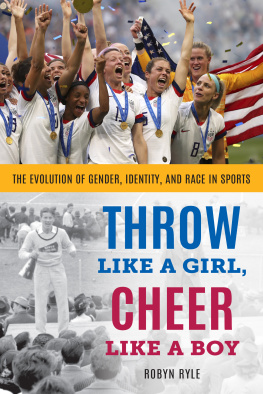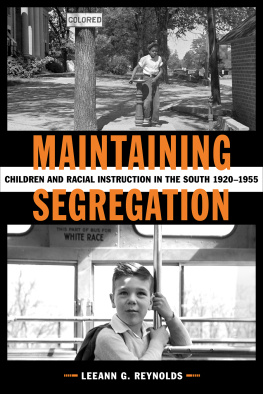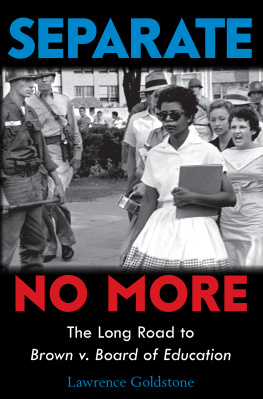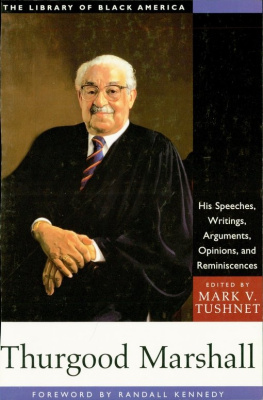SEX SEGREGATION IN SPORTS Why Separate Is Not Equal
Adrienne N. Milner and Jomills Henry Braddock II
Copyright 2016 by Adrienne N. Milner and Jomills Henry Braddock II All rights reserved. No part of this publication may be reproduced, stored in a retrieval system, or transmitted, in any form or by any means, electronic, mechanical, photocopying, recording, or other wise, except for the inclusion of brief quotations in a review, without prior permission in writing from the publisher. Library of Congress Cataloging- in- Publication Data
Names: Milner, Adrienne N., author. | Braddock, Jomills H., author. Title: Sex segregation in sports : why separate is not equal / Adrienne N. Milner and
Jomills Henry Braddock, II.
Description: Santa Barbara, California : Praeger, an imprint of ABC-CLIO, LLC, [2016] | Includes bibliographical references and index.
Identifers: LCCN 2015040363 | ISBN 9781440838101 (hard copy : acid-free paper) | ISBN 9781440838118 (ebook)
Subjects: LCSH: Sex discrimination in sportsUnited States. | Discrimination in sportsUnited States. | SportsSocial aspectsUnited States.
Classifcation: LCC GV706.32 .M55 2016 | DDC 796.082dc23 LC record available at http://lccn.loc.gov/2015040363
ISBN: 978-1-4408-3810-1
EISBN: 978-1-4408-3811-8
20 19 18 17 16 1 2 3 4 5
This book is also available on the World Wide Web as an eBook. Visit www . abc - clio . com for details.
Praeger
An Imprint of ABC- CLIO, LLC
ABC- CLIO, LLC
130 Cremona Drive, P.O. Box 1911
Santa Barbara, California 93116-1911
Contents
Figures v
Chapter One Introduction: Is Separate Equal in Sports? 1 Chapter Two Title IX: History, Results, and Controversies
of Separate but Equal 15
Chapter Three Title IX and Brown v. Board of Education : Intention, Implementation, and Outcomes
of Sex- Based vs. Race- Based Policy 37
Chapter Four The Social Construction of Sex and Race: Concepts Real Only in Their Consequences
and Why This Matters in Sports 51
Chapter Five The Politics of Opportunity: Intentions, Aftermath, and the Necessity for Change 79
Chapter Six The Elimination of Sex Categories in Sport: Benefts in Athletics and Beyond 95
Chapter Seven How Sex Integration Is Pos si ble:
Recommendations for Dismantling
Ideological and Structural Barriers to
Desegregation in Sports 117
Notes
Selected Bibliography
Index
This page intentionally left blank Figures
2.1 Number of Boys and Girls Participating in High School Sports: 19712014 21
2.2 Number of Males and Females Participating in College Sports: 19712014 25
3.1 Major Emphasis on Research on Brown (Race) and Title IX (Sex) Equity in Education 46
5.1 Number of Schools Allowing Girls to Participate in High School Male- Dominated Contact Sports: 19711972 to 20132014 86
5.2 Number of Girls Participating in High School Male- Dominated Contact Sports: 19711972 to 20132014 88
5.3 Percentage of High Schools Offering Girls Opportunities to Participate in Boys Contact Sports 90
6.1 High School Context and Males and Females Support for Coed Sports 114
This page intentionally left blank CHAPTER ONE
Int roduc t ion
Is Separate Equal in Sports?
In 2011, standout high school wrestler Joel Northrup refused to compete against Casey Herkelman in the Iowa state wrestling tournament for one reason: her sex. He was applauded for his decision to forfeit the match, and even Caseys father stated that he understood and respected Joels choice.
Likewise, the general public would not accept a male employer fring a female employee at his com pany, a male university president denying a female student admission, or a male landlord refusing to rent an apartment to a prospective female tenant on the sole basis of her sex. So why is sex treated differently in sports than in other social institutions? Furthermore, what are the consequences of sex segregation in sports for women and for society as a whole?
This book attempts to answer the question of why sex discrimination seems to be acceptable in sports contests and to address other issues sur-rounding the motivations and consequences of sex segregation in sports. By examining the similarities and differences in the manner in which sex and race categories are constructed and maintained, we question whether sex integration in sports contexts is pos si ble, and how it might best be achieved. Specifcally, this book begins by addressing the issue of sex segregation in
Sex Segregation in Sports
sports through an examination of two U.S. educational policies: Title IX, the federal law prohibiting sex discrimination in education; and the Brown v. Board of Education ruling, which declared the Plessy v. Ferguson decision separate but equal unconstitutional.
When thinking about Title IX legislation that focuses on sex and Brown v. Board of Education legislation that focuses on race, a so cio log i cal perspec- tive goes beyond the traditional understandings of these topics, demon-strating that the concepts of sex and race are similar and comparable because
they are both social constructions real only in their consequences and not in and of themselves. In addition, the tactics that have historically been used to discriminate against women and racial minorities are similar, where both groups were formally and informally barred from voting, owning property, and serving in the military, and continue to experience discrimination in employment and educational contexts. In sports specifcally, women and racial minorities have restricted opportunities for participation and both groups are signifcantly underrepresented in decision- making positions compared to their male and white counter parts.
Although we often discuss the concepts of sex and race separately throughout this book, we acknowledge the importance of intersectionality the understanding that neither sex nor race exists in a vacuum and that multiple aspects of such individuals identity characteristics as socio-economic status (SES), sexual orientation, and age intertwine to shape life chance opportunities. In addition, we acknowledge the unique experiences of women of color who endure interlocking forms of oppression associated with simultaneous membership in minority sex and race groups.
Both sex and race categories result from the division of individuals into socially constructed groups based on perceived biological differences. Examples of the social construction of race include the way in which the concept of whiteness has changed over time, how mixed- race individu-als are often labeled by the rule of hypodecent, where they are classifed as members of the lesser socially advantaged group, and the differential out-comes that result from group membership in such nuanced racial catego-ries as black Hispanic vs. white Hispanic and African immigrant vs. African American. Examples of the social construction of sex include that many such individuals as those who identify as transgender, intersex, and her-maphrodite transcend the traditional binary sex classifcation system, and previously assumed such innate sex differences as those associated with childrearing and intellectual ability are declining as women have increased their participation in the workforce and expanded their employment into nontraditional occupations in every sector of the labor market.













